READER COMMENTS ON
"Bush's 'Surge' Several Times Larger, More Expensive than Administration Claimed"
(23 Responses so far...)
COMMENT #1 [Permalink]
...
Ancient
said on 4/9/2007 @ 6:08 am PT...
How many lies can 1 administration tell?
As many as we let them.
IMPEACH NOW!
COMMENT #2 [Permalink]
...
Dredd
said on 4/9/2007 @ 6:12 am PT...
Congratulations Arlen, this is the type of word usage that will get you on the list:
A top Constitutional scholar from Princeton who gave a televised speech that slammed President George W. Bush's executive overreach recently learned that he had been added to the Transportation Security Administration's terrorist watch list.
(Raw Story).
If one calls bushies fascists one wonders whether that may qualify for "enemy combatant" status.
COMMENT #3 [Permalink]
...
big dan
said on 4/9/2007 @ 6:35 am PT...
They simply lie about everything. They don't tell the truth about anything. Remember the medicare projections?
The thing is, we KNOW they lie about everything. We said BEFORE this happened, that he would send more troops than he said, and that it would be more expensive than he said.
COMMENT #4 [Permalink]
...
Off the Grid
said on 4/9/2007 @ 8:48 am PT...
"Yet, less than one week later - the Pentagon comes back to the Congress to say they indeed need $2 billion more than they requested. Talk about a surge. If Pentagon officials can't add or subtract - how can we expect them to win a war?"
Win...AAAAAAAAAAAAAAAAAAAAAHHHHHHHHHHHHHHHHH...GOD BLESS AMERICA!!!!!!!!!!
My brother is part of this surge, he'll win the war the same way the rest of us will win......we'll be lucky to make it out alive, and after Bush, he/we won't have much of a home to come back to.
I say win the war NOW...Bush--->kangeroo court like we gave Saddam except we put his head on stake in the White House lawn when we're done. Keep Guantanamo...Cheney and Rummy can be the only inmates. Rove can personally go to Iran to fend off terrorist, but we'll only give him Nike and Roxy instead of a flack jacket and AR-15. That image of tubby Karl running from "terrorist" in nothing but a Roxy bikini and some fresh Nikes...priceless...watch the Neocons line up to be next.
COMMENT #5 [Permalink]
...
Ancient
said on 4/9/2007 @ 9:08 am PT...
You know, one of the arguments for not impeaching now (seems to indicate people believe they have committed impeachable acts) is that we would be too vulnerable during war time. Let me ask these questions, how vulnerable are we waiting for their WWIII? How many of our allies now call us illegal occupiers and tortures?
We will never show the world or the neocons that We The People abhor this administration with anything less than impeachment!
I suggest that Pelosi may very well come in line for Idiotboy's job, and she better start the conversation formulating an in depth strategy to deal with our top to bottom crisisses of democracy now, so people would be more open to taking the NECESSARY STEP!
If she doesn't, their WWIII is on her head too!
COMMENT #6 [Permalink]
...
Ancient
said on 4/9/2007 @ 9:20 am PT...
Great visuals OFF THE GRID!
Let THEM reap what they have sown, not us.
COMMENT #7 [Permalink]
...
big dan
said on 4/9/2007 @ 10:22 am PT...
Just wondering...did the NYTimes, ABC, or a blogger break this story of another one of Bush's lies?
COMMENT #8 [Permalink]
...
chabuka
said on 4/9/2007 @ 11:38 am PT...
And lets not forget about the 100,000 or more "private Blackwater mercenaries" already there..Bush's very own private, no rules, no-holds barred, non-accountable mercs, that we support with our tax dollars..somewhere around 40% of the "war budget" oh and yeah theres Halliburton too..we pay for them...can you think of any other "contractors"...I know you can!
COMMENT #9 [Permalink]
...
oldturk
said on 4/9/2007 @ 12:26 pm PT...
Now,... now,.. now people.
Think of it as burning the blood of our youth to fuel our SUV's. If we did not sacrifice our children on the alters of fascist capitalism - the oil barons would have to charge us $12.00/gallon for gasoline.
What is the big deal here ? Most of the dead bodies on the battlefield are from the ghetto not the gated communities of America. American democracy and freedom is not free, it is about time the poor picked up the tab.
http://thumbsnap.com/v/sWXCvuFP.jpg
http://thumbsnap.com/v/Qy0e6CEZ.jpg
COMMENT #10 [Permalink]
...
BUD,..BC BUD
said on 4/9/2007 @ 1:10 pm PT...
Yup, we're all desensitized now...3, 4 thousand, I'll still be shopping,eating yummies, does LouDobbs even still mention the count anymore?! Look, they Neeeed the troops for whatever current reason so's they can protect the oil they are stealing(including their pipeline to Kuwait no one talks about). They'll pump out a new reason after this,in perpituity. Lies, ya it's funny when they say they do stuff 'cause they Care about people,I laugh like it's a comedy skit. The U.S. has spent insanely,not for the citizens' benefit, -on a country which had been 'stable',(decent for women,sorta good lives for the majority compared to now)where Americans can can Never ever go touristing without dying or being kidnapped or worse. And now the Iraqi folks hate the U.S. as much as Iran,..hmmm,..oh well cut the next check.
COMMENT #11 [Permalink]
...
Ancient
said on 4/9/2007 @ 1:50 pm PT...
Talk about desensitized......that 16% that think they're doing a Heck of a Job and the others that can't be inconvenienced to think about the dead probably think, "Oh well, I'm sure they have a good reason they didn't tell the truth and that really doesn't affect me. You know, all the governments in the world lie. What's the big deal? They lie to protect us!" But you can bet they'll be incensed when the next illegal alien causes a drunk driving fatality. Meanwhile, their Granny has been abducted in a case of mistaken identity and special renditioned to a floating torture chamber somewhere in our "allied" world. I guess it will be "Oh well, at least we don't have to worry about what home to put her in any more."
COMMENT #12 [Permalink]
...
Ancient
said on 4/9/2007 @ 2:08 pm PT...
COMMENT #13 [Permalink]
...
Harold Ard
said on 4/9/2007 @ 2:38 pm PT...
I have heard this before. Surge, asking for more troops. Art Buchwald addressed this in the mid 60s when General Westmoreland was in charge in Vietnam. I can't find it on the net.
COMMENT #14 [Permalink]
...
Nuisance Man
said on 4/9/2007 @ 3:27 pm PT...
Why should they tell the truth? The American press won't tell the truth about what they're doing, and the Iraqi press can't. Check out this report from Dahr Jamail:
The international NGO Reporters Without Borders, which advocates freedom of the press, releases an annual worldwide press freedom index. Countries are ranked on the basis of surveys designed to record any kind of harassment of journalists and state violence against them that forces them to flee or abandon their work. In 2002, under Saddam Hussein and his draconian control of the media, Iraq ranked a dismal 130. In 2006, after three years of U.S. occupation, Iraq fell to 154.
You got that right…according to Reporters Without Borders, press freedom is WORSE today in Iraq that it was under Hussein. Partly this is just because the situation is so violent there that no one is safe, especially not people who have to gather information in different parts of town. Anything you can say will offend somebody, and somebody probably has a gun. But it’s also the consequence of direct suppression, such as the 2004 shutdown of al-Jazeera. It’s remarkable how many self-described freedom-loving Americans see nothing wrong with that. I mean, supposing Clinton had shut down Fox News for their negative coverage and endless, anti-government hit-pieces? It strikes me there would have been some ruckus about that. But it’s really only Americans whose freedom of speech counts; for everyone else, freedom means being Americanized. That’s the premise of American imperialism, and it always has been, ever since the days of disease-carrying blankets and prairie missionaries. If you self-consciously, articulately disagree with that, you’re considered disloyal…which, considering what you’re supposed to be loyal to, YOU ARE.
The U.S. directly manipulates and controls media in Iraq, planting stories partly to affect public opinion there, partly to affect it back here. The American government does not hesitate to censor. For example, according to Jamail’s article, Iraq’s Media High Commission sent a letter on the prime minister’s letterhead warning reporters to, “Stick to the government line on the U.S. led offensive in Fallujah or face legal action,” and “set aside space in your news coverage to make the position of the Iraqi government, which expresses the aspirations of most Iraqis, clear.”
More here
COMMENT #15 [Permalink]
...
Eyeball Kid
said on 4/9/2007 @ 4:34 pm PT...
What can be done about an executive branch that shows total contempt for Congress? Further, what can be done about those who are IN CONGRESS who support the executive branch? That's got to be the height of insanity: Republicans who are in agreement with Bush that he should abuse them at every turn. Are they all colluding to destroy the Constitution for corporate gain, or am I stating the obvious?
COMMENT #16 [Permalink]
...
Eyeball Kid
said on 4/9/2007 @ 4:34 pm PT...
What can be done about an executive branch that shows total contempt for Congress? Further, what can be done about those who are IN CONGRESS who support the executive branch? That's got to be the height of insanity: Republicans who are in agreement with Bush that he should abuse them at every turn. Are they all colluding to destroy the Constitution for corporate gain, or am I stating the obvious?
COMMENT #17 [Permalink]
...
sane-2
said on 4/9/2007 @ 10:18 pm PT...
TALKING POINTS ON ENDING THE IRAQ WAR
WARMONGERING HACK: So when do you think we should get out?
YOU: (Look them right in the eyes with the passion the guys on my website would want you to have and say) NOW!
There will be a pause and their wiring will go a little crazy because they are not prepared for this, so continue.
YOU: We want them out now, not next month not next year, NOW NOW NOW.
YOU: We need to redeploy at the borders, we need to gather intelligence, we need to impeach bush and Cheney and we need our overextended kids home now. We need to clean up the borders, the foreign policy, the justice system, GSA, Education, and EPA. We have so many problems in this country and it is directly caused by Bush, Cheney, and AEI's Iraq War, Iran Plan, and surge long and surge hard plan.
As long as Bush listens to these guys he has proven that he is choosing for this country to ride itself off a cliff (do research on AEI, they are on TV all the time telling us to fear Iran and we cannot give up on Iraq, and they are connected to PNAC). He needs to be impeached for the very least offense of putting our armed forces in harm's way without being able to see reality.
They will keep telling you about how you are a liberal pinko commie pussy who wants this country to lose and more BS. Just think of your children, your brothers and sisters. They would not cower from such a blatantly BS statement. You need to fight this w3ar here. The answer is now!
Our generals are capable of coming up with an exit plan in 90 days. 90 days we could be out (go ahead and challenge this), but it has to start today.
Eventually you will realize that they do not want to stay to win, they want to stay to keep control of oil by putting up 12 bases around pipelines. You will also realize that they want conflict so the price stays high. And unfortunately you will see that they are so ready to give up 100+ soldiers lives a month to do it (and $100= billion a year).
They will say we need to give the prez a chance, this is a trap, and they are planning to be there forever. The only answer is NOW, anything else a politician says is total BS. Stop being wishy washy, they do not have any information that you don't. They are messing with your heads.
OK HERE ARE YOUR TALKING POINTS -
Q: If you have been asleep for a while and you wake up to find that you are in a car and a blind person is driving, when would you cut off the engine?
A: NOW I would take the keys away now. If he did not give up the keys, I would punch him in the face remove the keys and jump the hell out
Anything else is BS, we need to take the keys away, that is what cutting the funding does.
We have so much work to do here, and we cannot start till we get the heck out. This life size GI Joe play set for chimp boy's birthday is done, OVER. He has already chopped off the heads of most of the toys and infected the rest with uranium. We need to get out now!!!!!!!!!!!!!
It is time to take his toys away; he obviously thinks this is a game. So does anyone else that insults the deaths of our children by saying, "You are not saying we should lose are you? Or, you are admitting defeat, mommy the democrat admitted defeat nya nya you are a loser." Hey butthead, this is not a game, we got real shit to deal with here, so stop screwing with people with your shallow talking points that you program into our heads like we are monkeys.
PLAYTIME IS FUCKING OVER!!!!!!!!
Oh, but what about our leaders, our politicians. Stick Ryan in front of these lapdogs and head givers (Not my quote, ed of Nation on Colbert an hour ago) and see what he says. Here is what I would like to see in the interview:
CNN:
Hey democratic politician, surely you have a plan for victory with a timeline and with milestones? And surely you know that you cannot win because of the veto power of the pres and the Republicans that are in his pocket with money and blackmail. Surely you know we are only providing some theatrical performance in this interview, so what say you?
DEM POLITICIAN:
Actually fuckface that helped sponsor this war like you were Lipton and this was 1980's tennis, I have only one timeline. We are getting out now! Chimp boy gets no money, not one penny and if he does not start getting our military out of harms way he needs to be impeached today. In addition currently arrested for treason and crimes against humanity are the following:
AEI published author and blackmail pawn of the president: Jeff Gannon/Johnny Gosh Planner of the current "SURGE LONG AND SURGE HARD" pornographic slaughter route for our children and the upcoming "Iran Bloodbath:" Michael Ledeen AEI published constitutional destroyer and appeaser to the chimp crushing a child's testicles if it will make the father talk: John Yoo Destroyer of the US Judicial System: Antonio Donzales Destroyer of FEMA: Michael Chertoff Destroyer of GSA: Lurita Alexis Doan (YOU STOLE FROM US) Destroyer of EPA: Christina Whitman (YOU LIED TO US) Destroyer of US Education: Margaret Spellings (HOW COULD YOU ACCEPT THIS JOB???)
Others: (oh you know them all by now, you see them all over the 24/7 news shows talking about the fear of Iran and if we leave now if will be worse-LIES LIES LIES)
Any other question you murderer of our children with your scrolling mindfucks telling us to fear Iran and your sights and sounds trying to rally us to death.
No, no questions?
Well I have a question for you...how long will you be locked up for treason for what you helped do and are continuing to do to our country before you take that bed sheet and end the nightmares?
CARE TO ANSWER THAT ONE?
COMMENT #18 [Permalink]
...
Dredd
said on 4/10/2007 @ 6:27 am PT...
Nuisance Man # 14
You quoted:
"In 2002, under Saddam Hussein and his draconian control of the media, Iraq ranked a dismal 130. In 2006, after three years of U.S. occupation, Iraq fell to 154."
Yep, that was because of McCain's recent "wonderful shopping trip to Baghdad" where he experimented with "journalism".
The Iraq press ratings dropped to 154, his poll numbers fell thru the floor, and Fox "news" had a neoCon orgasm and offered him a job as a "journalist".
Hallifalujah ... McCain has finally found his calling.
COMMENT #19 [Permalink]
...
Bernie Kite
said on 4/10/2007 @ 7:08 am PT...
Looks like the US has been poking Iran with a sharp stick: We kidnap 5 of their citizens who are in Iraq legally and by invitation, and we "disappear" them; our naval fleet is perched off Iran's coast; and now Bush is bulking up our military in Iraq. There is pretty general agreement outside of Bush circles that a "surge" will accomplish little in the long run in Iraq. But Iran is just across the border, isn't it? It would certainly be handy to have our troops so conveniently located if or when Bush decides to attack Iran. Then all will work out just lovely, won't it?
Me thinks there may be more to Pelosi's trip than meets the eye.
COMMENT #20 [Permalink]
...
peter
said on 4/10/2007 @ 7:57 am PT...
FACT CHECKING?
The above "surge" figures do not include the increased number of personnel deployed nor the increased costs for
the second largest Coalition of the Rented armed force in Iraq- the Mercenaries (Blackwater, et.al)
COMMENT #21 [Permalink]
...
Arlen
said on 4/10/2007 @ 8:06 am PT...
Peter: The figures cited above do in fact include two estimates of the increased number of support personnel, one based on Congressional Budget Office figures and a second based on Pentagon figures. As for civilian contractors- that's a whole other issue.
COMMENT #22 [Permalink]
...
GWN
said on 4/11/2007 @ 1:07 pm PT...
#17 sane-2, WOW that was great! You're a good ranter.
COMMENT #23 [Permalink]
...
kevin
said on 5/7/2007 @ 7:28 pm PT...
www.cchreus.org and click on fraudulent marketing
When school authorities tell a mother that her son is sick and needs to be on drugs ,how in the world is she to know that ,that is simply a lie . How is she to recognize that what experts now call "SCHIZOPHRENIA" is simply not a disease now,such a mother is not an expert in the history of psychiatry,she does not know that psychiatrist have for hundreds of years used diagnostic terms,so called diagnostic terms,to stigmatize and control people I will only give you a few aromatic examples when BLACK SLAVES in the south ran away to freedom, it wasn't that they wanted to be free they suffered from a disease called dropetomania from drapetes run away slave,and mania I'AM NOT MAKING THIS UP ! . This was a a legitmate diagnosis just like SCHIZOPHRENIA woman half the population of mankind,of course, if they were foolish enough to rebel against domination by man well then they had a serious disease called HYSTERIA , which was due to their wandering womb.now none of those behaviors was ever a disease and, of course, is not a disease nor is SCHIZOPHRENIA disorder a desease no behavior or misbehavior is a disease or can be a disease. that's not what diseases are so it doesn't matter how child behaves . there is nothing to examine . if he is sick then there must be some objective science to it . which can be diagnosed by physicians and objective test . that's why as soon as you go to a doctor they take a lot of blood and take x-rays. they don't want to hear how you behave. when I went to medical school sixty years ago there were only a handful of mental diseases . I think there were no more than six or seven . now there are more than three hundred .And now ones are quote," discovered"every day . labeling a child as mentally ill is stigmatization,not diagnosis. giving a child a psychiatric drug is poisoning ,not treatment .Diseases are malfunction of the human body ,of the heart , the liver the kidney,the heart, the liver the kidney,the brain and so forth . typhoid fever is a disease, you all know that , you don't question that spring fever all you have to know is English . Spring fever is not a disease. the task we get ourselves, to combat psychiatric coercison is important. I think it's important you all think it's important not enough people think it's important , it's a noble task, a task in the pursuit of which we must , regardless of obstacles, persevere, our conscience commands that we do no less.



 Sunday 'Close Enough' Toons
Sunday 'Close Enough' Toons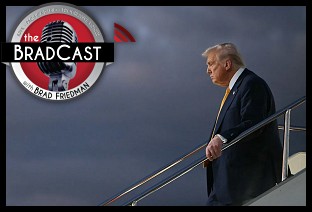 A Pretty Weak 'Strongman': 'BradCast' 10/30/25
A Pretty Weak 'Strongman': 'BradCast' 10/30/25 'Green News Report' 10/30/25
'Green News Report' 10/30/25
 Proposal for 'First Politically Viable Wealth Tax' Takes Shape in CA: 'BradCast' 10/29/25
Proposal for 'First Politically Viable Wealth Tax' Takes Shape in CA: 'BradCast' 10/29/25 Monster Storm, Endless Wars, Gamed Elections:
Monster Storm, Endless Wars, Gamed Elections: 'Green News Report' 10/28/25
'Green News Report' 10/28/25 Let's Play 'Who Wants
Let's Play 'Who Wants Sunday 'Cartoonists Dilemma' Toons
Sunday 'Cartoonists Dilemma' Toons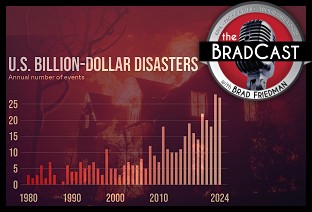 Exiled NOAA Scientists Resurrect Critical Disaster Database: 'BradCast' 10/23/25
Exiled NOAA Scientists Resurrect Critical Disaster Database: 'BradCast' 10/23/25  'Green News Report' 10/23/25
'Green News Report' 10/23/25 Trump-Allied GOP Partisan Buys Dominion Voting Systems: 'BradCast' 10/22/25
Trump-Allied GOP Partisan Buys Dominion Voting Systems: 'BradCast' 10/22/25 Trump, Republican Law(lessness) & (Dis)Order: 'BradCast' 10/21/25
Trump, Republican Law(lessness) & (Dis)Order: 'BradCast' 10/21/25 'Green News Report' 10/21/25
'Green News Report' 10/21/25 Celebrating 'No Kings': 'BradCast' 10/20/25
Celebrating 'No Kings': 'BradCast' 10/20/25 Sunday 'How It Started' Toons
Sunday 'How It Started' Toons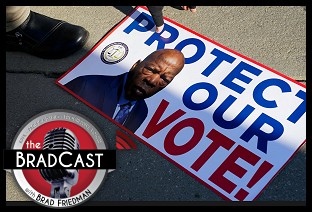 SCOTUS Repubs Appear Ready to Gut Rest of Voting Rights Act: 'BradCast' 10/16/25
SCOTUS Repubs Appear Ready to Gut Rest of Voting Rights Act: 'BradCast' 10/16/25 'Green News Report' 10/16/25
'Green News Report' 10/16/25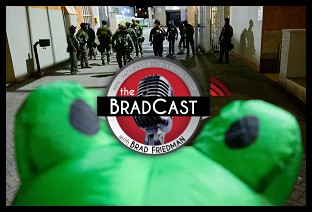 The 'Epstein Shutdown' and Other Autocratic Nightmares: 'BradCast' 10/15/25
The 'Epstein Shutdown' and Other Autocratic Nightmares: 'BradCast' 10/15/25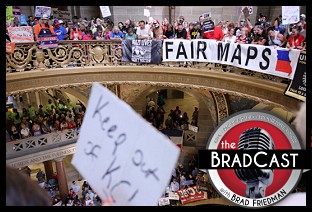 Group Vows to Block MO's GOP U.S. House Gerrymander: 'BradCast' 10/14/25
Group Vows to Block MO's GOP U.S. House Gerrymander: 'BradCast' 10/14/25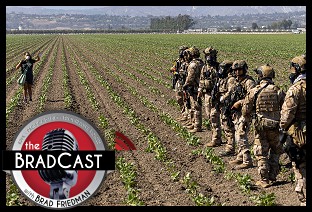 Trump Labor Dept. Warns Trump Policies Sparking Food Crisis: 'BradCast' 10/9/25
Trump Labor Dept. Warns Trump Policies Sparking Food Crisis: 'BradCast' 10/9/25 Trump's Losing Battles: 'BradCast' 10/8/25
Trump's Losing Battles: 'BradCast' 10/8/25 Trump, Roberts and His Stacked, Packed and Captured SCOTUS: 'BradCast' 10/7/25
Trump, Roberts and His Stacked, Packed and Captured SCOTUS: 'BradCast' 10/7/25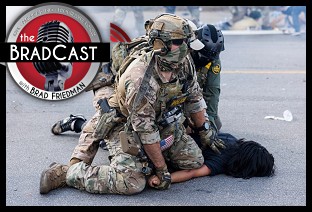 Trump Attempting His 'Invasion from Within': 'BradCast' 10/6/25
Trump Attempting His 'Invasion from Within': 'BradCast' 10/6/25 Biden Budget Expert: Mass Firings in Shutdown 'Illegal': 'BradCast' 10/2/25
Biden Budget Expert: Mass Firings in Shutdown 'Illegal': 'BradCast' 10/2/25 Why is DOJ Suing 'Blue' States for Their Voter Databases?: 'BradCast' 10/1/25
Why is DOJ Suing 'Blue' States for Their Voter Databases?: 'BradCast' 10/1/25
 VA GOP VOTER REG FRAUDSTER OFF HOOK
VA GOP VOTER REG FRAUDSTER OFF HOOK Criminal GOP Voter Registration Fraud Probe Expanding in VA
Criminal GOP Voter Registration Fraud Probe Expanding in VA DOJ PROBE SOUGHT AFTER VA ARREST
DOJ PROBE SOUGHT AFTER VA ARREST Arrest in VA: GOP Voter Reg Scandal Widens
Arrest in VA: GOP Voter Reg Scandal Widens ALL TOGETHER: ROVE, SPROUL, KOCHS, RNC
ALL TOGETHER: ROVE, SPROUL, KOCHS, RNC LATimes: RNC's 'Fired' Sproul Working for Repubs in 'as Many as 30 States'
LATimes: RNC's 'Fired' Sproul Working for Repubs in 'as Many as 30 States' 'Fired' Sproul Group 'Cloned', Still Working for Republicans in At Least 10 States
'Fired' Sproul Group 'Cloned', Still Working for Republicans in At Least 10 States FINALLY: FOX ON GOP REG FRAUD SCANDAL
FINALLY: FOX ON GOP REG FRAUD SCANDAL COLORADO FOLLOWS FLORIDA WITH GOP CRIMINAL INVESTIGATION
COLORADO FOLLOWS FLORIDA WITH GOP CRIMINAL INVESTIGATION CRIMINAL PROBE LAUNCHED INTO GOP VOTER REGISTRATION FRAUD SCANDAL IN FL
CRIMINAL PROBE LAUNCHED INTO GOP VOTER REGISTRATION FRAUD SCANDAL IN FL Brad Breaks PA Photo ID & GOP Registration Fraud Scandal News on Hartmann TV
Brad Breaks PA Photo ID & GOP Registration Fraud Scandal News on Hartmann TV  CAUGHT ON TAPE: COORDINATED NATIONWIDE GOP VOTER REG SCAM
CAUGHT ON TAPE: COORDINATED NATIONWIDE GOP VOTER REG SCAM CRIMINAL ELECTION FRAUD COMPLAINT FILED AGAINST GOP 'FRAUD' FIRM
CRIMINAL ELECTION FRAUD COMPLAINT FILED AGAINST GOP 'FRAUD' FIRM RICK SCOTT GETS ROLLED IN GOP REGISTRATION FRAUD SCANDAL
RICK SCOTT GETS ROLLED IN GOP REGISTRATION FRAUD SCANDAL VIDEO: Brad Breaks GOP Reg Fraud Scandal on Hartmann TV
VIDEO: Brad Breaks GOP Reg Fraud Scandal on Hartmann TV RNC FIRES NATIONAL VOTER REGISTRATION FIRM FOR FRAUD
RNC FIRES NATIONAL VOTER REGISTRATION FIRM FOR FRAUD EXCLUSIVE: Intvw w/ FL Official Who First Discovered GOP Reg Fraud
EXCLUSIVE: Intvw w/ FL Official Who First Discovered GOP Reg Fraud GOP REGISTRATION FRAUD FOUND IN FL
GOP REGISTRATION FRAUD FOUND IN FL

































